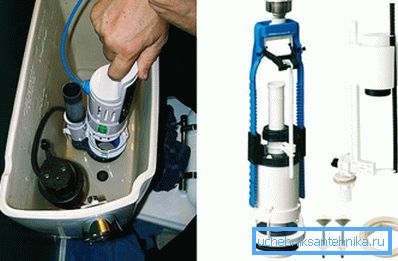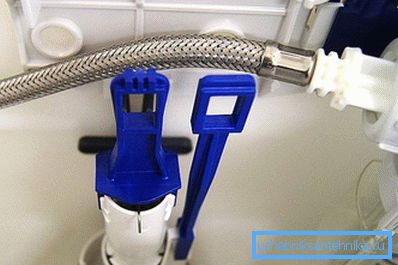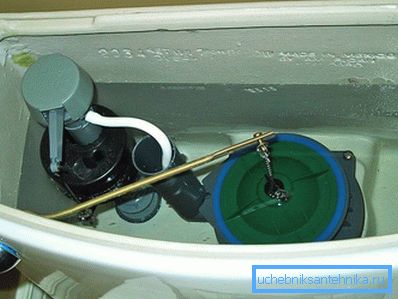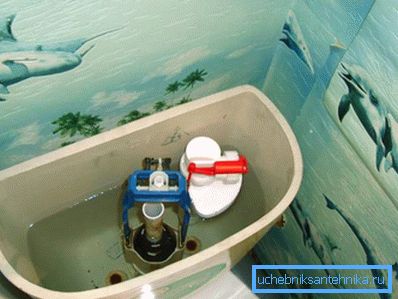How to install the fittings in the toilet cistern
Installing fittings in the drain tank can extend the service life of plumbing equipment for several years. One of the most common reasons for calling a plumber is the problem of filling the tank. This is due to the rapid failure of parts of the discharge mechanism, or fittings, due to poor water quality.
The composition of the drain tank

The quality of the toilet bowl depends on the quality and “filling” of the cistern. Its breakdown significantly complicates the life of any family. Therefore, the choice of the toilet bowl and the mechanism should be taken as responsibly as possible.
Any drain tank has the following parts:
- Actually tank, which will contain water.
- The armature regulating the filling of the tank.
- The mechanism of discharge of water.
- Button to drain the water.
The most common reasons for the termination of the functioning of the mechanism of the drain tank are:
- Failure of the drain button.
- Breakage of the valve, which regulates the filling of the tank.
- Failure of the "rocker", directly responsible for draining water in the toilet.

All these problems can be solved independently, without resorting to the help of plumber. An excellent preventive measure for any breakdowns can be the installation of toilet fittings. It will ensure uninterrupted operation in any conditions for the long term.
Armature for flush tank

Valves today is the most effective means of preventing the most common problems with the drain.
The mechanism of the flush tank is a complex of the following parts:
- Drain mechanism having an angular slope (in some models is located below).
- Overflow pipe located slightly to the side.
- The mechanism that fills the tank with a new portion of water.
- The mechanism includes a drain function.
Tip! Proper and uninterrupted functioning of the cistern depends largely on how to adjust the toilet bowl fittings. This is done immediately after the installation of sanitary products in the bathroom. Or, if it was not done immediately during installation - during the next repair.
Fitting installation

The valve will prevent water from flowing out of the cistern and will regulate the flushing - either full or partial.
Structurally, the mechanisms for draining water can vary considerably depending on the manufacturer. Therefore, when purchasing fittings, it is necessary to carefully inspect the mechanism. This will help:
- understand how it functions;
- to determine its weakest points - in the event that in the future it will be necessary to replace the valve of the cistern;
- identify defects in parts that can disable the entire drain mechanism in the near future.
Tip! The valve of the cistern looks like a complex mechanism, and at the same time it is quite possible to install it yourself without resorting to the services of a plumber.
If fittings are installed before installing the toilet bowl, this requires:
- Place a rubber gasket on top of the drainage mechanism.
- Install the tank drain fittings in the tank and gently, but not overtightening, attach it with the supplied nut, mainly plastic.
- Fixing bolts need to be equipped with rubber gaskets and with their help attach the mechanism.
After installation of the fittings, the tank should be installed on the toilet, water should be supplied to the drain tank and a test drain should be carried out.
Adjusting the height of the reinforcement is as follows:
- First you need to disconnect the traction placed on the overflow pipe.
- The release mechanism latch is released so that the “glass” of the reinforcement can freely move vertically.
- Carefully adjust the position of the tank drain valve to the desired level. To the top level of the tank (without cover) there should not be more than 4–5 cm.
- To fix its condition and bring the cradle back so that the overflow pipe is at least 1–2 cm above the water.
- If the drain mechanism has the function of draining half of the tank, you will have to adjust it with the help of a small flush float.
Replacement

In some cases, the already installed drain mechanism fails. Often problems arise due to the deformation of some poor-quality parts of the reinforcement, especially if a cheap option has been installed. Water also has a great influence: its excessive rigidity can negatively affect the condition of the reinforcement. Even foreign mechanisms do not save. They are designed for a different composition of water and often break down from excess impurities in the incoming water.
Tip! To replace the drain tank fittings, turn off the water supply to the drain tank, remove the cover and carefully inspect the mechanism itself. In some cases, damage can be fixed by replacing one part.
How does the malfunction of the drain mechanism:
- Constant flow of water into the toilet.
- Constant flow of water into the tank.
The first case is caused by a change in the position of the float regulating the water level. To eliminate the problem, it is necessary to correct the position of the float. If the manipulations did not help, you need to change the float - it is possible that it has a defect that allows it to pass water and transfer incorrect data about the water level to the drain mechanism.
The second case indicates that the membrane in the siphon of the drain mechanism has failed. It is necessary to replace it with a new part.

However, if the drain mechanism is installed for a long time, all its parts have worn out so that installing new ones will not help. So, you need to change the entire discharge mechanism.
When purchasing a valve for a flush tank, you need to make sure that all its parts do not have any damage, the mechanism works properly. You can purchase another kit as insurance.
Video
We offer to watch a video about the replacement of fittings in the toilet bowl: